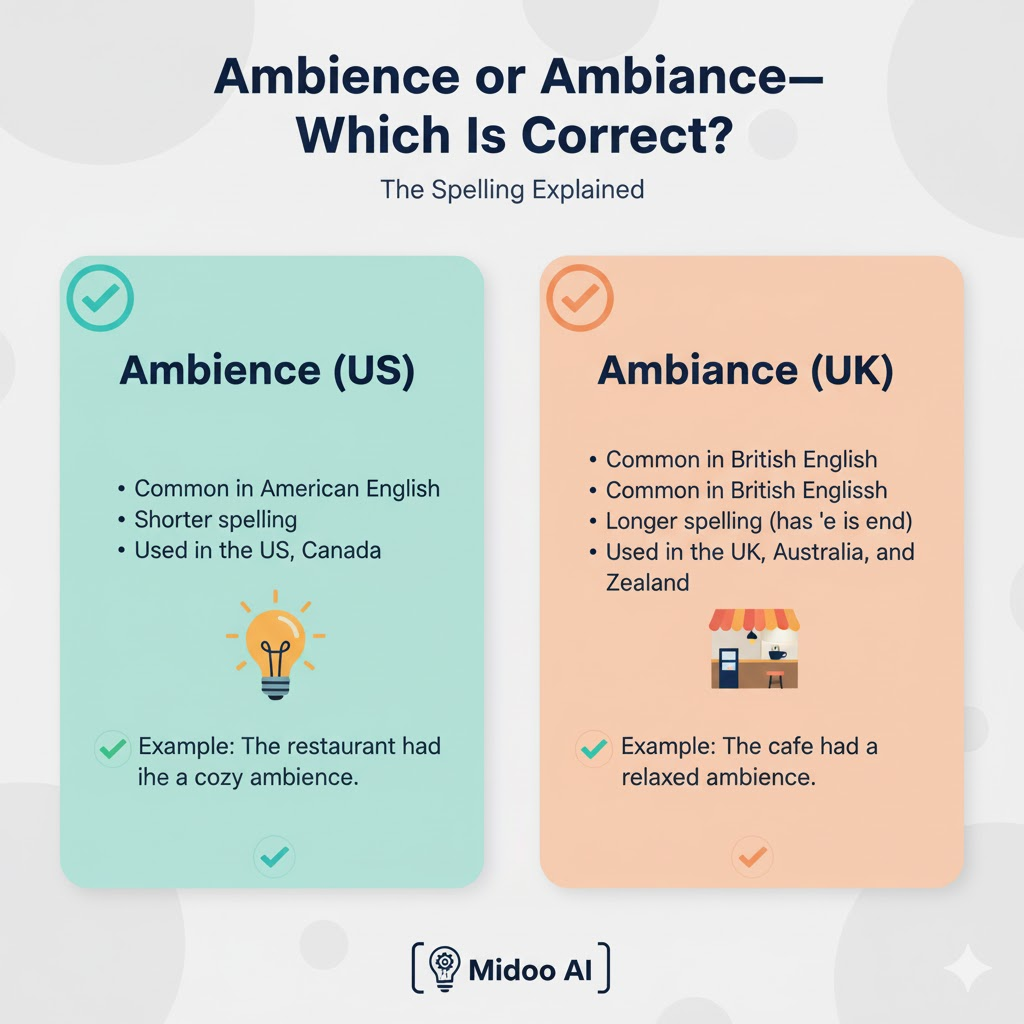Ambience or Ambiance—Which Spelling Is Correct?

If you’ve ever paused while writing a review of a cozy café or describing a restaurant’s mood, you might have wondered—should you say ambience or ambiance? Both spellings appear in English, but is there any real difference between them?
At Midoo AI, we know that subtle spelling distinctions can confuse even advanced learners. Words like color/colour, defense/defence, and ambience/ambiance all stem from language history—especially French influence. Let’s explore what makes ambience and ambiance different (and when to use each correctly).
1. The Core Meaning
Both ambience and ambiance mean the mood, atmosphere, or feeling of a place. They describe the emotional or sensory environment that surrounds someone.
✅ Examples:
- The ambience of the café made me feel relaxed.
- The restaurant’s ambiance was elegant and romantic.
- The ambience in the room changed when the lights dimmed.
In other words, both words describe the same concept—there’s no difference in meaning.
2. The Subtle Spelling Difference
- Ambience → Preferred in British English
- Ambiance → More common in American English and when emphasizing sophistication or French influence
Both forms come from the French noun “ambiance”, which means environment or surroundings.
English borrowed the word in the 19th century, first adapting it to ambience to fit English spelling rules, then later re-adopting the original French form ambiance—especially in contexts related to design, dining, or luxury.
✅ Quick summary:
| Variant | Region | Common Use | Example |
|---|---|---|---|
| Ambience | British English | Everyday use | The hotel’s ambience was warm and welcoming. |
| Ambiance | American English | Stylish or artistic tone | The candlelight created a romantic ambiance. |
3. Which One Should You Use?
If you’re writing in:
- 🇺🇸 American English: Use ambiance (especially for restaurants, events, or décor).
- 🇬🇧 British English: Use ambience (it’s standard and slightly more traditional).
However, in practice, both are understood everywhere. The difference is mostly stylistic, not grammatical.
💡 Tip from Midoo AI:
If you want your writing to sound more elegant, use ambiance.
If you prefer a neutral, modern English tone, go with ambience.
4. Common Examples in Context
Ambience (British English):
- The hotel’s ambience felt calm and luxurious.
- Soft lighting and jazz music added to the bar’s ambience.
- We loved the seaside ambience of the restaurant.
Ambiance (American English):
- The restaurant’s ambiance made it perfect for a date night.
- The designer aimed for a minimalist ambiance in the lobby.
- The holiday lights created a cheerful ambiance downtown.
5. Common Mistakes to Avoid
❌ Writing “ambients” — that’s not a valid plural form.
✅ Both ambience and ambiance are uncountable nouns (you don’t say “two ambiences”).
❌ Mixing styles in one document (e.g., “The hotel’s ambience and ambiance were great”).
✅ Stay consistent—choose one spelling and stick to it.
6. Quick Memory Trick
Both words mean mood or feeling, but here’s an easy way to remember:
✨ Ambiance = Fancy.
Use it when you want your sentence to sound refined, French-inspired, or elegant.
☕ Ambience = Common.
Use it in everyday English for a calm, neutral description.
7. Real-Life Usage
- Ambience is used by outlets like BBC, The Guardian, and The Telegraph.
- Ambiance appears more often in The New York Times, Vogue, and travel magazines.
So, if you’re writing for an international or U.K. audience, ambience is the safe choice. For a U.S. or lifestyle-focused tone, ambiance fits better stylistically.
FAQS
Q1: Are ambience and ambiance pronounced differently?
No—they’re pronounced the same: /ˈæmbiəns/. The only difference lies in spelling and tone.
Q2: Is “ambience” outdated?
Not at all. It’s still widely used in both academic and professional writing, especially in British contexts.
Q3: Can I use both spellings in one document?
It’s better not to. Choose one version and remain consistent throughout your text.
Q4: Which spelling do Canadians use?
Canadian English leans toward ambience, following British convention, but ambiance is also acceptable in design and lifestyle writing.
Q5: Is one more formal than the other?
Slightly. Ambiance can sound more polished or high-end, while ambience feels neutral and modern.